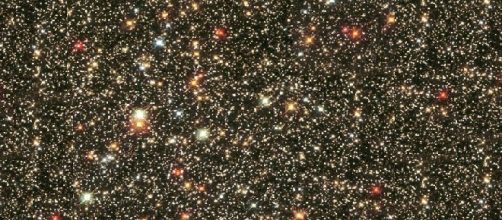Hubble space telescope focused its optical equipment towards our own Milky Way galaxy and in the direction of Sagittarius to gain a fantastic view of an array of stars with different colors and masses. The optical image shows stars of varied shades and hues, including red, yellow and blue stars. Their colors and sizes may provide useful information, such as their temperature and the span of time they will spend consuming their fuel.
Sagittarius
Is one of the modern 88 constellations and also one of the 13 constellations of the zodiac -- the group of constellations situated on the ecliptic.
It lies in the center of the Milky Way. The Milky Way is densest at its center; therefore, Sagittarius contains in this region star clusters and nebulae.
Star nurseries
Stars from in regions of molecular clouds consisting mostly of hydrogen and one quarter percent of helium in addition with trace amounts of heavier elements. Stars in these regions form in groups of a few dozens to several hundreds of thousands. Massive stars are known to illuminate surrounding masses and ionizing the hydrogen to create H11 regions. Stars often show varied properties throughout their development and their existence depends on their masses.
Very low mass stars
These types of stars have masses one half or less the mass of the sun and never become hot enough to fuse helium.
Their life span may exceed the age of the universe. These types of stars will eventually burn its hydrogen and become a white dwarf of helium-4 nuclei; however, since their life extends longer than the age of the universe, none star of this type has reached the stage of conversion.
Low to medium mass stars in deep space is a mesmerizing experience.These stars usually have a mass between 0.5 to 8 solar masses. Their core becomes sufficiently hot to fuse helium onto carbon and oxygen; however, their temperature does not raise too high for the fusion process of carbon into neon. Over time, these stars explode as planetary nebulas.
Massive stars
Dense stars with 7-10 solar masses. After burning the hydrogen contained on their cores, these types of stars become super giants and begin the fusion of heavier than helium elements. They end their development when their cores collapse under the force of gravity and explode as supernovae.

